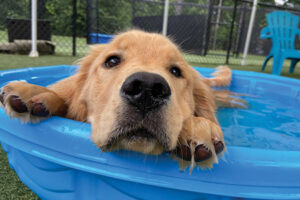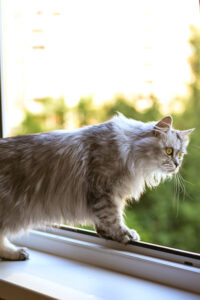 Summer months can be dangerous for pets, especially if they are left outside without water and shade or travel in the car with you. With the warmer weather comes some unexpected dangers, so it’s a good idea to have your vet on speed dial. From overheating on too long of a walk or run, to asphalt burns and insect bites, summer can be a dangerous time if you’re not prepared. These summer safety tips for pets can help you avoid some of the major risks such as:
Summer months can be dangerous for pets, especially if they are left outside without water and shade or travel in the car with you. With the warmer weather comes some unexpected dangers, so it’s a good idea to have your vet on speed dial. From overheating on too long of a walk or run, to asphalt burns and insect bites, summer can be a dangerous time if you’re not prepared. These summer safety tips for pets can help you avoid some of the major risks such as:
Risk #1: Leaving Your Pet in a Hot Car!
(Leave Your Pets at Home)
Your pets would rather be at home in air conditioning than wait in the car while you run errands— even if they don’t realize it. Especially when it’s hot out, it can quickly be fatal! The inside of your car reaches higher temperatures in minutes. If it’s 85 degrees outside, the inside of a car will rise to 102 degrees in ten minutes or less! The inside of your car will always be about 20 degrees hotter than the outside temperature, even with windows cracked!
Leaving the windows down and/or parking in the shade won’t provide enough relief and your pet will be at risk for heatstroke and death. Also, Don’t allow animals to ride in the back of a pick-up truck. They may jump out or could be thrown out. The American Veterinary Medical Association recommends that pets be secured either by a kennel in the truck bed or by a harness inside the cab.
Risk #2: Asphalt Burns
Taking your pup for extra-long walks now that the weather is sunny? Always check the outside temperature before going on a walk. Asphalt heats up very quickly and stays hot for a while, even after the sun goes down. Also, check hot sand on the beach which can blister tender paws.
If you can’t avoid walking on streets and sidewalks, make a trip on your own first. Check the temperature of the ground using the back of your hand or by stepping on it barefoot. Hold your hand or bare foot down for a minimum of 7 seconds. If it’s too hot for you, it’s even hotter for your pup. And be aware that after swimming, paw pads soften and burn even faster than normal.
Risk #3: Overheating
Hot weather means a higher chance of overheating, especially if you’re spending long periods of time outdoors. Shade alone might not be enough to prevent overheating (especially if it’s humid), but it’s a good start. Whether you’re going for a walk or just spending time in the yard, watch out for signs of heatstroke and make sure there are shady areas where your pet can seek refuge.
Always make sure your pet has cool, clean water available. Plenty of cool water and even some frozen treats – like ice cubes or frozen green beans – are also a must. This is one of the easiest ways to avoid heat injuries in the summer months. Dogs, and even cats, drink more on hot days, and water warms up quickly, so make sure to change your pet’s water often.
Outdoor dogs can knock over their water and have no access to hydration for hours, resulting in death. However long you could tolerate being outside or in a hot garage, know that your pet can’t handle it as well as you.
If you have a pet with long hair, grooming can be another way to help them battle the heat. Also keep in mind that very short hair exposes the skin and can increase the chances of sunburn, especially in pets with a light coat. If you’re not sure how short to go, talk to your groomer or your vet to figure out the best options.
Learn the signs of heat stress from exposure to extreme temperatures. Check your pet for signs like heavy panting, glazed eyes, rapid heartbeat, restlessness, excessive thirst, lethargy, fever, dizziness, lack of coordination, profuse salivation, or vomiting.
If your pet is overheating, immediately move your pet into the shade or an air-conditioned area and offer them cool water or ice cubes. If they are not responding or symptoms worsen, contact your vet right away.
 Risk #4: High-Rise Syndrome
Risk #4: High-Rise Syndrome
High-rise syndrome refers to the danger of pets (especially curious cats) falling from open windows, fire escapes or balconies. While you probably think of cats as animals with great balance, the truth is that accidents do happen—especially if your pet gets distracted by a nearby bird or squirrel. As you can imagine, the warmer weather means open windows and doors, which helps to make these accidents a more common threat to pet summer safety.
A good solution is to install strongly-fastened screens in all your windows. Baby gates and sliding windows are not always enough unless they can be locked securely to keep your pet indoors.
Risk #5: Insect Bites
Aside from the more obvious dangers summer brings, there’s another potential issue some people often ignore: insects. One of our top summer safety tips for pets includes checking your pet daily for fleas and ticks. Apply flea and tick prevention to your pet monthly or as indicated on the specific product. Fleas and ticks can cause anemia, carry other harmful parasites or diseases such as Lyme Disease.
Mosquitoes are not only a nuisance, but they can also transmit a number of diseases including heartworm.
Animal-safe bug repellents are available through your vet and some pet stores. Never use human products on pets, as they can be highly toxic.
We hope these top summer safety tips for pets will help you keep your fur babies happy and healthy throughout the sunny season!
Going Out on the Water this Summer?
Here are Tips on Fitting your Pet with a Life Jacket
When you’re headed out on the water with your pet, one of the most important items to have for them is a life jacket. Just like you wouldn’t let your kids go on a boat without one, the same principle applies to your fur baby.
Pick out a life jacket that seems comfortable to your pet as they may be wearing it all day. Make sure it’s not too loose or too tight. Having a jacket with a strong handle will help if you need to pull your dog back onto a dock or boat. Find one in a bright color so you can see it, even in dim light.
All dogs really need life jackets when in the water or on a boat. Breeds like Frenchies, Pugs, and Bulldogs can be hard to fit because they are short-necked and dense. Make sure to take proper measurements to ensure the best fit. Here’s a helpful video with more information on how to fit a life vest on your pet:



